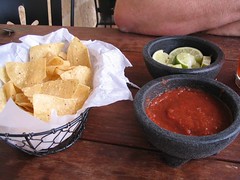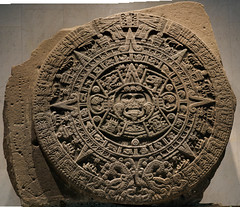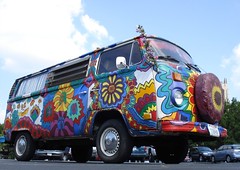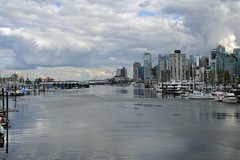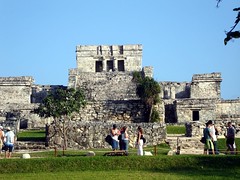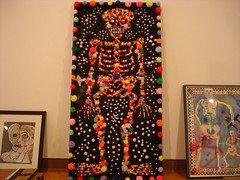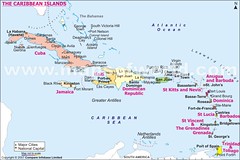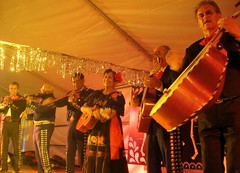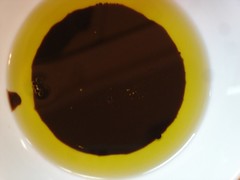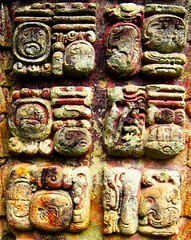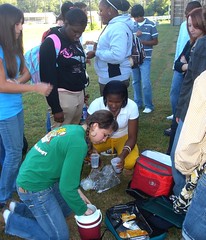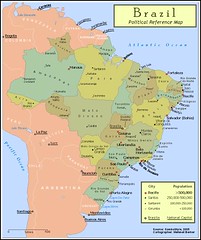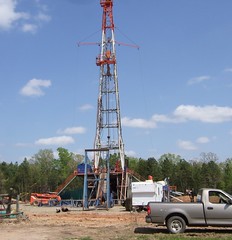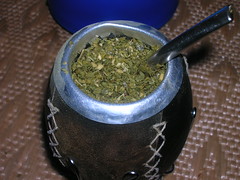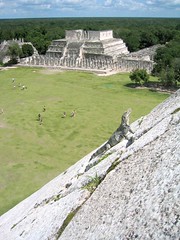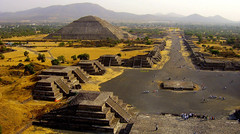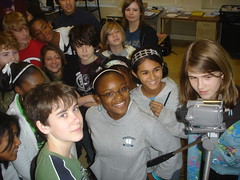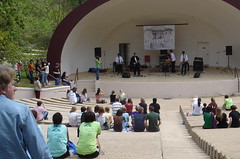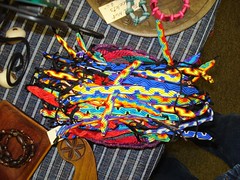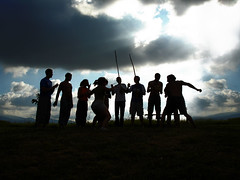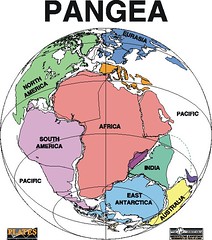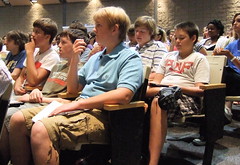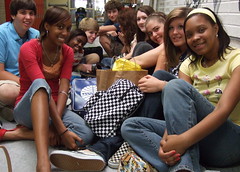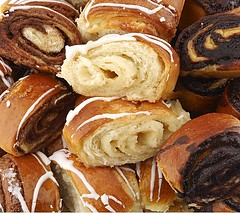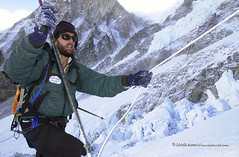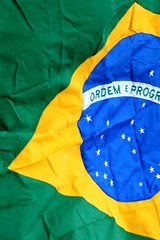The cuisine that would come to be called Tex-Mex actually originated with Tejanos (Texans of Hispanic descent) as a hybrid of Spanish and native Mexican foods when Texas was part of New Spain and later Mexico.
From the South Texas region between San Antonio and the Rio Grande Valley, this cuisine has had little variation and from earliest times has always been influenced by the cooking in the neighboring northern states of Mexico.
Tex-Mex cuisine is characterized by its heavy use of melted cheese, meat (particularly beef), beans, and spices, in addition to Mexican-style tortillas. Texas-style chili con carne, chili con queso, chili gravy, and fajitas are all Tex-Mex inventions.[citation needed]
Serving tortilla chips and a hot sauce or salsa as an appetizer is common in Tex-Mex restaurants.[citation needed] Moreover, Tex-Mex has imported flavors from other spicy cuisines, such as the use of cumin (common in Indian food but used in only a few authentic Mexican recipes).
Then what is Mexican cooking all about?
When conquistadores arrived in the Aztec capital Tenochtitlan (now Mexico City), they found that the people's diet consisted largely of corn-based dishes with chilies and herbs, usually complemented with beans and tomatoes. The conquistadores eventually combined their imported diet of rice, beef, pork, chicken, wine, garlic and onions with the native indigenous foods of pre-Columbian Mexico, including chocolate, maize, tomato, vanilla, avocado, guava, papaya, pineapple, jicama, chile pepper, beans, squash, sweet potato, peanut, fish and turkey.
Most of today's Mexican food is based on ancient traditions, such as the Aztecs and Maya, combined with culinary trends introduced by Spanish colonists.
Quesadillas, for example, are a flour or corn tortilla with cheese (often a Mexican-style soft farmer's cheese such as Queso Fresco or Queso Oaxaca ), beef, chicken, pork, and so on. The indigenous part of this and many other traditional foods is the chili pepper. Foods like these tend to be very colorful because of the rich variety of vegetables (among them are the chili peppers, green peppers, chilies, broccoli, cauliflower, and radishes) and meats in Mexican food.
Friday, October 31, 2008
Thursday, October 30, 2008
Mesoamerica quiz for geographarians
1. Indigenous people of the Yucatan: a) Aztec b) Maya
c) Guatemalans d) Mexican tribal peoples.
2. Inasmuch as the Mayans created an effective calendar for Mesoamerican (meso: “middle” America) peoples, we can say they must have been competent at a) astrology b) math c) language d) agriculture.
3. International success in Association football, aka soccer, is an achievement of a) Mexico b) Brazil c) Venezuela d) Argentina.
4. Central and South America are regions united by the usage of one great language: Spanish. T / F
5. Both Mexico and Brazil’s economies have been directly enhanced by the North American Free Trade Agreement, aka NAFTA. T / F
6. Chichen Itza is a notable element of the Mayan culture. It is equivalent to . . . a) Caribbean b) Cuba c) Paris d) Rocky Mountains.
7. Closest to the Yucatan peninsula: a) Jamaica b) Haiti
c) Bahamas d) Cuba.
8. Port-au-Prince is the capital of a) Jamaica b) Haiti
c) Bahamas d) Cuba.
9. Carnaval is a fabulous celebration in the nation of a) Mexico b) Brazil c) Venezuela d) Argentina.
10. While Cuba is communist, at least the islands of Puerto Rico, the US Virgin Islands and Haiti are controlled by the US. T / F
11. The Caribbean names St Croix and Basse-Terre indicate that among the Caribbean colonial powers were the a) Spanish b) Italian c) English d) French.
12. Russia is a member of the petroleum-controlling association of nations called OPEC. T / F
13. Among the G7 nations, the elite of the current world, we will find a) Nigeria b) Brazil c) Saudi Arabia d) Canada.
14. When chocolate was brought to the Old World in the Columbian Exchange, the kings of Europe adopted it as a royal drink. T / F
15. Associated with the storms caused by the climate phenomenon called El Nino: a) Equatorial current b) California current c) Gulf Stream d) Canary current.
16. Dia de Los Muertos, Day of the Dead, is a celebration associated with the a) Cubans b) Haitians c) Mexicans d) Brazilians.
Wednesday, October 29, 2008
Enrichment: bios on Bob Marley and Richard Branson
Bob Marley, Jamaican songwriter-performer, put Kingston, Jamaica and the patois of Jamaicans on the world map. Items from the life of Marley that have had an impact on our culture:
- Rastafarianism
- ska
- dreadlocks
- song titles, including "I shot the sheriff" and "Exodus"
- melanoma
- Jamaican patois, or slang
Richard Branson, British retail and travel mogul, won his first fame with Virgin Records. He expanded into travel with Virgin Atlantic Airways. Later he entered the communications arena with Virgin Mobile.
A billionaire, he owns an island in the British Virgin Islands as well as properties on the Caribbean islands of Antigua and Barbuda.
Branson has won much notice for Virgin Galactic, a company that will soon offer rides in space. In the green realm, he has created Virgin Fuels and the Virgin Earth Challenge.
He has also won media coverage for his adventures in record-setting sailing and ballooning voyages.
- Rastafarianism
- ska
- dreadlocks
- song titles, including "I shot the sheriff" and "Exodus"
- melanoma
- Jamaican patois, or slang
Richard Branson, British retail and travel mogul, won his first fame with Virgin Records. He expanded into travel with Virgin Atlantic Airways. Later he entered the communications arena with Virgin Mobile.
A billionaire, he owns an island in the British Virgin Islands as well as properties on the Caribbean islands of Antigua and Barbuda.
Branson has won much notice for Virgin Galactic, a company that will soon offer rides in space. In the green realm, he has created Virgin Fuels and the Virgin Earth Challenge.
He has also won media coverage for his adventures in record-setting sailing and ballooning voyages.
Tuesday, October 28, 2008
Caribbean overview
Caribbean overview -
1. A communist nation?
2. Nation that is the source of reggae?
3. Island that is the largest US possession?
4. Island that is closest to South America?
5. Islands closest to Florida?
6. Nation upon which Columbus’ first set his foot?
7. Which island has a capital city on a bay that was recognized as a smart place to weather a storm?
8. Which is the poorest nation in the Western Hemisphere?
9. What is the traditional and still the chief crop of most islands?
10. What's the meaning of St Croix?
vocab
- Eurocentric
- ethnocentric
- volatile (as in the financial market is currently volatile)
- archipelago
- “rich port”
- a haven
- embargo
- isthmus
1. A communist nation?
2. Nation that is the source of reggae?
3. Island that is the largest US possession?
4. Island that is closest to South America?
5. Islands closest to Florida?
6. Nation upon which Columbus’ first set his foot?
7. Which island has a capital city on a bay that was recognized as a smart place to weather a storm?
8. Which is the poorest nation in the Western Hemisphere?
9. What is the traditional and still the chief crop of most islands?
10. What's the meaning of St Croix?
vocab
- Eurocentric
- ethnocentric
- volatile (as in the financial market is currently volatile)
- archipelago
- “rich port”
- a haven
- embargo
- isthmus
A few words about the Hippie ethic
Hippie day is a fun costume occasion for you but an opportunity for me to explain the countercultural philosophy born in the late 60's.
a) DIY ethic, or Do It Yourself style. An example would be tie-dyed T-shirts.
b) Non-materialist: forget the big house and fancy car; live in a log cabin or teepee and drive a self-repaired vehicle. Sew your own clothing.
c) Non-conformist: as in a guitar or vehicle painted in floral designs and bright colors. Also, don't try to straighten your wavy or wiry hair. Let it grow naturally and embrace the curliness.
d) Back to the land: buy some country acreage with a communal group of partners. Make a garden. Grow your own.
e) Go organic; avoid the fast-food culture and preservative-filled foods.
d) Hippies looked like war protestors but were basically apolitical, which means not concerned at all with politics.
e) Native American influence. Beads, feathers, long skirts, fringed leather, etc. etc.
a) DIY ethic, or Do It Yourself style. An example would be tie-dyed T-shirts.
b) Non-materialist: forget the big house and fancy car; live in a log cabin or teepee and drive a self-repaired vehicle. Sew your own clothing.
c) Non-conformist: as in a guitar or vehicle painted in floral designs and bright colors. Also, don't try to straighten your wavy or wiry hair. Let it grow naturally and embrace the curliness.
d) Back to the land: buy some country acreage with a communal group of partners. Make a garden. Grow your own.
e) Go organic; avoid the fast-food culture and preservative-filled foods.
d) Hippies looked like war protestors but were basically apolitical, which means not concerned at all with politics.
e) Native American influence. Beads, feathers, long skirts, fringed leather, etc. etc.
The G7 nations to meet and face the financial crisis
World economic crisis solutions to be tackled by reps of the G7 nations.
The G7: Group of 7 nations
1. US
2. GB / UK
3. France
4. Germany
5. Italy
6. Japan
7. Canada
The G7: Group of 7 nations
1. US
2. GB / UK
3. France
4. Germany
5. Italy
6. Japan
7. Canada
Maya review
Review of the Maya
1. In which region of Mexico do the Maya reside?
2. The approximate date for the peak of the Maya empire?
3. The distinctive architecture includes what type of structure?
4. Name an area of technological achievement.
5. The Europeans had a serious problem with the Maya religious practice. Which part?
1. Yucatan peninsula
2. Maya society peaked about 900 CE.
3. Their pyramids have endured over a thousand years in a difficult environment.
4. Astronomy, calendar creation, math, writing, architecture, agriculture.
5. Human sacrifice seemed normal to the Maya and to the Aztecs.
1. In which region of Mexico do the Maya reside?
2. The approximate date for the peak of the Maya empire?
3. The distinctive architecture includes what type of structure?
4. Name an area of technological achievement.
5. The Europeans had a serious problem with the Maya religious practice. Which part?
1. Yucatan peninsula
2. Maya society peaked about 900 CE.
3. Their pyramids have endured over a thousand years in a difficult environment.
4. Astronomy, calendar creation, math, writing, architecture, agriculture.
5. Human sacrifice seemed normal to the Maya and to the Aztecs.
In B--3: a quick comparison of Caribbean islands
To be scored before the end of the period:
5 slide comparison of 2 of the Caribbbean islands.
Include a map and 4 photos.
3 pts.
5 slide comparison of 2 of the Caribbbean islands.
Include a map and 4 photos.
3 pts.
Monday, October 27, 2008
Dia de los Muertos, Shreveport
At azcentral.com there is a super site for learning about Dia de Los Muertos, says student Heidi Holman. She writes "Mr. T if you go to http://www.azcentral.com/ent/dead/ and go under video for teachers and students you will find a pdf file that you can open and it gives you all kinds of stuff on Dia de los Muertos that i thought you might want to use!"
Thanks, Heidi!
Thanks, Heidi!
Sunday, October 26, 2008
The sugary, colorful, Creole archipelago called the Carribbean
Nations and Islands in the geography unit and quiz on Thurs:
the Bahamas
Cuba
Haiti
Dominican Republic
Jamaica
Puerto Rico
Trinidad
also, Florida
Nicaragua
Venezuela
The open notes quiz on Thurs is on
Brazil
Mexico
Cortez and Columbus
Caribbean islands via the atlas.
the Bahamas
Cuba
Haiti
Dominican Republic
Jamaica
Puerto Rico
Trinidad
also, Florida
Nicaragua
Venezuela
The open notes quiz on Thurs is on
Brazil
Mexico
Cortez and Columbus
Caribbean islands via the atlas.
Oct 27 - 31 in geography: contrasting Mexico and the Caribbean islands
Thurs
- Brief open notes, multiple choice quiz
- Hand-sketched map of the principal Caribbean islands
Fri
- Mexican food and mask- celebration of Dia de los Muertos
Mon - Wed
- Reports on Mexico & Brazil
- Review of Mayans and Aztecs
Indie work
- research and compare the conquistadores Hernan Cortez and Christopher Columbus.
- Brief open notes, multiple choice quiz
- Hand-sketched map of the principal Caribbean islands
Fri
- Mexican food and mask- celebration of Dia de los Muertos
Mon - Wed
- Reports on Mexico & Brazil
- Review of Mayans and Aztecs
Indie work
- research and compare the conquistadores Hernan Cortez and Christopher Columbus.
Friday, October 24, 2008
OPEC and the price of a barrel of crude oil
The 12 oil-rich nations who comprise the cartel called OPEC have decided to precipitously cut production, says the NYTimes.
Crude reached a high of $145 a bbl the summer of 2008. Today it has spiraled to $64.
"For consumers, falling commodity prices have been one of the only positive developments in a profoundly depressed economic landscape. If OPEC’s cut eventually sends oil prices higher, that would be another blow to the global economy," wrote the NY Times.
The Organization of the Petroleum Exporting Countries (OPEC) is a cartel of 13 countries[2], says Wikipedia, made up of Algeria, Angola, Ecuador, Indonesia, Iran, Iraq, Kuwait, Libya, Nigeria, Qatar, Saudi Arabia, the United Arab Emirates, and Venezuela. The organization has maintained its headquarters in Vienna since 1965.
Crude reached a high of $145 a bbl the summer of 2008. Today it has spiraled to $64.
"For consumers, falling commodity prices have been one of the only positive developments in a profoundly depressed economic landscape. If OPEC’s cut eventually sends oil prices higher, that would be another blow to the global economy," wrote the NY Times.
The Organization of the Petroleum Exporting Countries (OPEC) is a cartel of 13 countries[2], says Wikipedia, made up of Algeria, Angola, Ecuador, Indonesia, Iran, Iraq, Kuwait, Libya, Nigeria, Qatar, Saudi Arabia, the United Arab Emirates, and Venezuela. The organization has maintained its headquarters in Vienna since 1965.
Indigenous people of the Yucatan peninsula: the Maya
The Maya civilization is a Mesoamerican civilization, says Wikipedia. It is noted for the only known fully developed written language of the pre-Columbian Americas, as well as its spectacular art, monumental architecture, and sophisticated mathematical and astronomical systems.
They reached an apogee of development during the Classic period (c. 250 CE to 900 CE), and continued until the arrival of the Spanish. At its peak, it was one of the most densely populated and culturally dynamic societies in the world.
Advances such as writing, epigraphy, and the calendar did not originate with the Maya; however, their civilization fully developed them.
Their strengths were in astronomy, writing, math, architecture, calendar development and agriculture.
The Maya practiced human sacrifice. In some Maya rituals people were killed by having their arms and legs held while a priest cut the person's chest open and tore out his heart as an offering. This is depicted on ancient objects such as pictorial texts, known as codices (singular: codex). It is believed that children were often offered as sacrificial victims because they were believed to be pure.
The largest Mayan sites:
Cancuén
Chichen Itza
Coba
Copán
Kalakmul
Palenque
Tikal
They reached an apogee of development during the Classic period (c. 250 CE to 900 CE), and continued until the arrival of the Spanish. At its peak, it was one of the most densely populated and culturally dynamic societies in the world.
Advances such as writing, epigraphy, and the calendar did not originate with the Maya; however, their civilization fully developed them.
Their strengths were in astronomy, writing, math, architecture, calendar development and agriculture.
The Maya practiced human sacrifice. In some Maya rituals people were killed by having their arms and legs held while a priest cut the person's chest open and tore out his heart as an offering. This is depicted on ancient objects such as pictorial texts, known as codices (singular: codex). It is believed that children were often offered as sacrificial victims because they were believed to be pure.
The largest Mayan sites:
Cancuén
Chichen Itza
Coba
Copán
Kalakmul
Palenque
Tikal
Tijuana to Sao Paulo quiz / Trudeau
Tijuana to Sao Paulo quiz / Trudeau
1. Name the nation discovered for the Europeans by a gentleman named Vasco da Gama, not Christopher Columbus: a) Brazil b) Mexico c) Venezuela d) Costa Rica.
2. Word which describes the Amerindians: a) indigenous
b) creoles c) noble savages d) colonists.
3. Which is the most effective nation in association football? a) Mexico b) Brazil c) Venezuela d) Argentina.
4. Cattle ranching and agriculture, logging, mining, oil and gas extraction, over-fishing, expansion of urban centers, wildlife trade, fire, climate change, water contamination, and invasive species are a threat to which nation? a) Mexico b) Brazil c) Venezuela d) Argentina.
5. Both Mexico and Brazil’s economies have been aided by the North American Free Trade Agreement, aka NAFTA. T / F
6. The US states of California, Nevada, Utah, Arizona, New Mexico, Texas and parts of Colorado and Wyoming were once part of Mexico. T / F
7. When Europeans brought chocolate to the New World in the Columbian Exchange, the kings of Mexico adopted it as a royal drink. T / F
8. The Mayans lived around the site of today’s Mexico City and were defeated by the Spanish under Cortez. T / F
9. Associated with the storms caused by the climate phenomenon called El Nino: a) Equatorial current
b) California current c) Gulf Stream d) Canary current.
10. Capoeira is a Mexican art form that integrates martial arts, games and dance, says Wikipedia. T / F
Constructed response answer - choose one topic:
a) Cite 2 factors in a comparison of Mexico and Brazil that might indicate which nation’s economy will be have the strongest economy a decade from now. Be specific; use statistics in each case.
b) Cite 3 ways in which Americans benefit from Mexico. Be specific.
Remember -
- Explosive opening.
- Title that has two levels and is dangerous.
- Documentation: “... says geography teacher Robert Trudeau,” or other appropriate source.
Wednesday, October 22, 2008
Brazil: the basic notes
The Federative Republic of Brazil (Portuguese: República Federativa do Brasil), is the largest and most populous country in South America.[5] It is the fifth largest country by geographical area, the fifth most populous country, and the fourth most populous democracy in the world, according to Wikipedia.
The Brazilian population is predominantly Roman Catholic, almost all Portuguese-speaking and multiethnic.[6] Brazil is also home to a diversity of wildlife, natural environments, and extensive natural resources in a variety of protected habitats.
Unlike Christopher Columbus, who thought he had reached India, the Portuguese Vasco da Gama had already reached India sailing around Africa two years before he reached Brazil.
Nevertheless, the word índios ("Indians") was by then established to designate the peoples of the New World and stuck being used today in the Portuguese language, while the people of India are called indianos.
Initially, the Europeans saw the natives as noble savages, and miscegenation (cohabitation and creolization) of the population began right away. Tribal warfare and cannibalism convinced the Portuguese that they should "civilize" the Amerindians.[12]
The climate of Brazil comprises a wide range of weather conditions across a large geographic scale and varied topography, but the largest part of the country is tropical.[5] Analysed according to the Köppen system, Brazil hosts five major climatic subtypes: equatorial, tropical, semiarid, highland tropical, and temperate; ranging from equatorial rainforests in the north and semiarid deserts in the northeast, to temperate coniferous forests in the south and tropical savannas in central Brazil.
Brazil's large territory comprises different ecosystems, such as the Amazon Rainforest, recognized as having the greatest biological diversity in the world;[76] the Atlantic Forest and the Cerrado, which together sustain some of the world's greatest biodiversity.
Scientists estimate that the total number of plant and animal species in Brazil could approach four million.[77] Larger mammals include pumas, jaguars, ocelots, rare bush dogs, and foxes. Peccaries, tapirs, anteaters, sloths, opossums, and armadillos are abundant. Deer are plentiful in the south, and monkeys of many species abound in the northern rain forests.
Its natural heritage is extremely threatened by to cattle ranching and agriculture, logging, mining, resettlement, oil and gas extraction, over-fishing, expansion of urban centres, wildlife trade, fire, climate change, dams and infrastructure, water contamination, and invasive species.[76] In many areas of the country, the natural environment is threatened by development.
Brazil is the largest national economy in Latin America, the world's tenth largest economy at market exchange rates[83][84] and the ninth largest in purchasing power parity (PPP),[85][86] according to the International Monetary Fund and the World Bank; with large and developed agricultural, mining, manufacturing and service sectors, as well as a large labor pool.
Brazil's booming economy is shifting into overdrive, with biofuels and deep-water oil providing energy independence and the government collecting enough cash to irrigate the desert and pave highways across the Amazon Rainforest.
Most Brazilians can trace their ancestry to the country's indigenous Amerindians, Portuguese colonists, or African slaves, either alone, in combination with one or both of the others, and/or in combination with other ethnic or racial groups.
Brazil is the only Portuguese-speaking nation in the Americas, making the language an important part of Brazilian national identity and giving it a national culture distinct from its Spanish-speaking neighbors.
Brazil's cultural tradition extends to its music styles which include samba, bossa nova, forró, frevo, pagode, and many others.[146] Brazil has also contributed to classical music, which can be seen in the works of many composers.
The festival of Carnival (Portuguese: Carnaval), with its spectacular street parades and vibrant music, has become one of the most potent images of Brazil;[145] an annual celebration held forty days before Easter and marks the beginning of Lent.
Football is the most popular sport in Brazil.[145] The Brazilian national football team (Seleção) have been victorious in the FIFA World Cup tournament a record five times, in 1958, 1962, 1970, 1994 and 2002.[153]
Basketball, volleyball, auto racing, and martial arts also attract large audiences. Some sport variations have their origins in Brazil. Beach football,[154] futsal (official version of indoor football)[155] and footvolley emerged in the country as variations of football. In martial arts, Brazilians have developed Capoeira,[156] Vale tudo,[157] and Brazilian Jiu-Jitsu.[158] In auto racing, Brazilian drivers have won the Formula 1 world championship eight times.
The Brazilian population is predominantly Roman Catholic, almost all Portuguese-speaking and multiethnic.[6] Brazil is also home to a diversity of wildlife, natural environments, and extensive natural resources in a variety of protected habitats.
Unlike Christopher Columbus, who thought he had reached India, the Portuguese Vasco da Gama had already reached India sailing around Africa two years before he reached Brazil.
Nevertheless, the word índios ("Indians") was by then established to designate the peoples of the New World and stuck being used today in the Portuguese language, while the people of India are called indianos.
Initially, the Europeans saw the natives as noble savages, and miscegenation (cohabitation and creolization) of the population began right away. Tribal warfare and cannibalism convinced the Portuguese that they should "civilize" the Amerindians.[12]
The climate of Brazil comprises a wide range of weather conditions across a large geographic scale and varied topography, but the largest part of the country is tropical.[5] Analysed according to the Köppen system, Brazil hosts five major climatic subtypes: equatorial, tropical, semiarid, highland tropical, and temperate; ranging from equatorial rainforests in the north and semiarid deserts in the northeast, to temperate coniferous forests in the south and tropical savannas in central Brazil.
Brazil's large territory comprises different ecosystems, such as the Amazon Rainforest, recognized as having the greatest biological diversity in the world;[76] the Atlantic Forest and the Cerrado, which together sustain some of the world's greatest biodiversity.
Scientists estimate that the total number of plant and animal species in Brazil could approach four million.[77] Larger mammals include pumas, jaguars, ocelots, rare bush dogs, and foxes. Peccaries, tapirs, anteaters, sloths, opossums, and armadillos are abundant. Deer are plentiful in the south, and monkeys of many species abound in the northern rain forests.
Its natural heritage is extremely threatened by to cattle ranching and agriculture, logging, mining, resettlement, oil and gas extraction, over-fishing, expansion of urban centres, wildlife trade, fire, climate change, dams and infrastructure, water contamination, and invasive species.[76] In many areas of the country, the natural environment is threatened by development.
Brazil is the largest national economy in Latin America, the world's tenth largest economy at market exchange rates[83][84] and the ninth largest in purchasing power parity (PPP),[85][86] according to the International Monetary Fund and the World Bank; with large and developed agricultural, mining, manufacturing and service sectors, as well as a large labor pool.
Brazil's booming economy is shifting into overdrive, with biofuels and deep-water oil providing energy independence and the government collecting enough cash to irrigate the desert and pave highways across the Amazon Rainforest.
Most Brazilians can trace their ancestry to the country's indigenous Amerindians, Portuguese colonists, or African slaves, either alone, in combination with one or both of the others, and/or in combination with other ethnic or racial groups.
Brazil is the only Portuguese-speaking nation in the Americas, making the language an important part of Brazilian national identity and giving it a national culture distinct from its Spanish-speaking neighbors.
Brazil's cultural tradition extends to its music styles which include samba, bossa nova, forró, frevo, pagode, and many others.[146] Brazil has also contributed to classical music, which can be seen in the works of many composers.
The festival of Carnival (Portuguese: Carnaval), with its spectacular street parades and vibrant music, has become one of the most potent images of Brazil;[145] an annual celebration held forty days before Easter and marks the beginning of Lent.
Football is the most popular sport in Brazil.[145] The Brazilian national football team (Seleção) have been victorious in the FIFA World Cup tournament a record five times, in 1958, 1962, 1970, 1994 and 2002.[153]
Basketball, volleyball, auto racing, and martial arts also attract large audiences. Some sport variations have their origins in Brazil. Beach football,[154] futsal (official version of indoor football)[155] and footvolley emerged in the country as variations of football. In martial arts, Brazilians have developed Capoeira,[156] Vale tudo,[157] and Brazilian Jiu-Jitsu.[158] In auto racing, Brazilian drivers have won the Formula 1 world championship eight times.
Notes on the world of carbon-based fuels and extracting the fuels from the earth
Why does the oil and gas industry first erect a steel tower, or superstructure, aka a derrick, when they begin drilling? The derrick
enables the crew to hoist up lengths of steel pipe (30 foot pieces, traditionally) that will be connected to the drill bit and sent on its way into the earth.
Today several innovations in extraction technology have become part of the energy industry -
- horizontal drilling (first the drill goes into the earth vertically - later it veers)
- steerable drill bit
- coil tubing (replacing the straight steel pipe)
enables the crew to hoist up lengths of steel pipe (30 foot pieces, traditionally) that will be connected to the drill bit and sent on its way into the earth.
Today several innovations in extraction technology have become part of the energy industry -
- horizontal drilling (first the drill goes into the earth vertically - later it veers)
- steerable drill bit
- coil tubing (replacing the straight steel pipe)
Tuesday, October 21, 2008
Constructed response: Why Mexico is an important ally to the US
Mini essay -
Base your brief paragraph on 3 reasons why Americans benefit from Mexico. Be specific and detailed.
Remember -
- Snappy opening.
- Vivid titling.
- Documentation.
Base your brief paragraph on 3 reasons why Americans benefit from Mexico. Be specific and detailed.
Remember -
- Snappy opening.
- Vivid titling.
- Documentation.
Indie work: holidays and pyramids
See your geography class score rise when you take advantage of the option called Indie Work!
Topics this week include
Research and compare
- Dia de los Muertos and Halloween.
- Aztec and Mayan culture, esepcially their pyramids.
A reminded of the criteria for comparison essays -
- Snacky title and explanatory subtitle
- Delicious opening (descriptive, quote-based, questions-based, etc)
- Integrated topics (weaves fingers together).
- Documentation (near end of first para).
- Typed.
- Spelling, logic and construction.
Topics this week include
Research and compare
- Dia de los Muertos and Halloween.
- Aztec and Mayan culture, esepcially their pyramids.
A reminded of the criteria for comparison essays -
- Snacky title and explanatory subtitle
- Delicious opening (descriptive, quote-based, questions-based, etc)
- Integrated topics (weaves fingers together).
- Documentation (near end of first para).
- Typed.
- Spelling, logic and construction.
Monday, October 20, 2008
Basic notes on the democratic nation of Mexíco
With an estimated population of 109 million,[9] it is the 11th most populous country and the most populous Spanish-speaking country in the world. Mexico is firmly established as an upper middle-income country, according to Wikipedia.[12
Mexico is a newly industrialized country[13][14][15][16] and the 12th largest economy in the world by GDP by purchasing power parity. The economy is strongly linked to those of its North American Free Trade Agreement (NAFTA) partners. Despite being considered an emerging power,[17] the uneven distribution of income and the increase in insecurity are issues of concern.
It was decided that the new country would be named after its capital city (Mexico City) that was founded in 1524 on top of the ancient Aztec capital of México-Tenochtitlan. The origin of the name of the city comes from the Nahuatl language, where Mextli or Mēxihtli, a secret name for the god of war and patron of the Aztecs, Huitzilopochtli, in which case Mēxihco means "Place where Mēxihtli lives".
Ancient civilizations revolved around cities with writing, monumental architecture, astronomical studies, mathematics, and large militaries. For almost three thousand years, Aridoamerica[24] and Mesoamerica[25] were the site of several advanced Amerindian civilizations.
Almost 300 years after New Spain was created, on September 16, 1810, independence from Spain was declared by Priest Miguel Hidalgo y Costilla, in the small town of Dolores, Guanajuato.[27] This was the catalyst for a long war that ended in 1821 which eventually led to the independence and creation of the ephemeral First Mexican Empire.
The Empire's territory encompassed the area of the current Mexican republic as well as the present-day U.S. states of California, Nevada, Utah, Arizona, New Mexico, Texas, parts of Colorado and Wyoming, and all current Central American countries except for Panama and Belize.
Mexico is one of the 18 megadiverse countries of the world. With over 200,000 different species, Mexico is home of 10–12% of the world's biodiversity.[74] Mexico ranks first in biodiversity in reptiles with 707 known species.
The discovery of the Americas brought to the rest of the world many widely used ingredients. Some of Mexico's native ingredients include: chocolate, tomato, maize, vanilla, avocado, guava, chayote, epazote, camote, jícama, nopal, tejocote, huitlacoche, sapote, mamey sapote, and many varieties of beans. Most of these names are in indigenous languages like Nahuatl.
Oil is Mexico's largest source of foreign income.[79] According to Goldman Sachs BRIMC review of emerging economies, by 2050 the largest economies in the world will be as follows: China, United States, India, Japan, Brazil, and Mexico.[80]
The North American Free Trade Agreement remains the most significant factor in business: Almost 90% of Mexican exports go to the United States and Canada[86] and close to 65% of its imports come from these two countries.
Mexico has one of the largest tourism industries in the world. In 2005 it was the seventh most popular tourist destination worldwide, receiving over 20 million tourists per year;
* Mestizos (those of mixed European and Amerindian ancestry) form the largest group, comprising up to 60-75% of the total population.[69][108]
* Amerindians called indigenous peoples (indígenas) are estimated to be between 12% (pure Amerindian)[109] and 30% (predominantly Amerindian).
Mexico is a newly industrialized country[13][14][15][16] and the 12th largest economy in the world by GDP by purchasing power parity. The economy is strongly linked to those of its North American Free Trade Agreement (NAFTA) partners. Despite being considered an emerging power,[17] the uneven distribution of income and the increase in insecurity are issues of concern.
It was decided that the new country would be named after its capital city (Mexico City) that was founded in 1524 on top of the ancient Aztec capital of México-Tenochtitlan. The origin of the name of the city comes from the Nahuatl language, where Mextli or Mēxihtli, a secret name for the god of war and patron of the Aztecs, Huitzilopochtli, in which case Mēxihco means "Place where Mēxihtli lives".
Ancient civilizations revolved around cities with writing, monumental architecture, astronomical studies, mathematics, and large militaries. For almost three thousand years, Aridoamerica[24] and Mesoamerica[25] were the site of several advanced Amerindian civilizations.
Almost 300 years after New Spain was created, on September 16, 1810, independence from Spain was declared by Priest Miguel Hidalgo y Costilla, in the small town of Dolores, Guanajuato.[27] This was the catalyst for a long war that ended in 1821 which eventually led to the independence and creation of the ephemeral First Mexican Empire.
The Empire's territory encompassed the area of the current Mexican republic as well as the present-day U.S. states of California, Nevada, Utah, Arizona, New Mexico, Texas, parts of Colorado and Wyoming, and all current Central American countries except for Panama and Belize.
Mexico is one of the 18 megadiverse countries of the world. With over 200,000 different species, Mexico is home of 10–12% of the world's biodiversity.[74] Mexico ranks first in biodiversity in reptiles with 707 known species.
The discovery of the Americas brought to the rest of the world many widely used ingredients. Some of Mexico's native ingredients include: chocolate, tomato, maize, vanilla, avocado, guava, chayote, epazote, camote, jícama, nopal, tejocote, huitlacoche, sapote, mamey sapote, and many varieties of beans. Most of these names are in indigenous languages like Nahuatl.
Oil is Mexico's largest source of foreign income.[79] According to Goldman Sachs BRIMC review of emerging economies, by 2050 the largest economies in the world will be as follows: China, United States, India, Japan, Brazil, and Mexico.[80]
The North American Free Trade Agreement remains the most significant factor in business: Almost 90% of Mexican exports go to the United States and Canada[86] and close to 65% of its imports come from these two countries.
Mexico has one of the largest tourism industries in the world. In 2005 it was the seventh most popular tourist destination worldwide, receiving over 20 million tourists per year;
* Mestizos (those of mixed European and Amerindian ancestry) form the largest group, comprising up to 60-75% of the total population.[69][108]
* Amerindians called indigenous peoples (indígenas) are estimated to be between 12% (pure Amerindian)[109] and 30% (predominantly Amerindian).
Yerba Mate, the national drink of Argentina
The infusion called maté is prepared by steeping dry leaves (and twigs) of yerba maté in hot water, rather than in boiling water like black tea, according to Wikipedia.
It is a slightly less potent stimulant than coffee and much gentler on the stomach[citation needed]. Drinking maté with friends from a shared hollow gourd (also called a mate in Spanish, or cabaça or cuia in Portuguese) with a metal straw (a bombilla in Spanish, bomba or canudo in Portuguese) is an extremely common social practice in Argentina,[3][4] Uruguay, Paraguay, southern Chile, eastern Bolivia and Southern Region, Brazil[5] and also Syria,Lebanon and Jordan.
The flavor of brewed yerba maté is strongly vegetal, herbal, and grassy, reminiscent of some varieties of green tea. Unlike most teas, it does not become bitter and astringent when steeped for extended periods, and the leaves may be infused several times. Additionally, one can purchase flavored maté in many varieties.
In Brazil, a toasted version of maté, known as chá mate or "maté tea", is sold in teabag and loose form, and served, sweetened, in specialized shops, either hot or iced with fruit juice or milk. An iced, sweetened version of toasted maté is sold as an uncarbonated soft drink, with or without fruit flavoring. The toasted variety of maté has less of a bitter flavor and more of a spicy fragrance. It is more popular in the coastal cities of Brazil, as opposed to the far southern states where it is consumed in the traditional way (green, drunk with a silver straw from a shared gourd).
It is a slightly less potent stimulant than coffee and much gentler on the stomach[citation needed]. Drinking maté with friends from a shared hollow gourd (also called a mate in Spanish, or cabaça or cuia in Portuguese) with a metal straw (a bombilla in Spanish, bomba or canudo in Portuguese) is an extremely common social practice in Argentina,[3][4] Uruguay, Paraguay, southern Chile, eastern Bolivia and Southern Region, Brazil[5] and also Syria,Lebanon and Jordan.
The flavor of brewed yerba maté is strongly vegetal, herbal, and grassy, reminiscent of some varieties of green tea. Unlike most teas, it does not become bitter and astringent when steeped for extended periods, and the leaves may be infused several times. Additionally, one can purchase flavored maté in many varieties.
In Brazil, a toasted version of maté, known as chá mate or "maté tea", is sold in teabag and loose form, and served, sweetened, in specialized shops, either hot or iced with fruit juice or milk. An iced, sweetened version of toasted maté is sold as an uncarbonated soft drink, with or without fruit flavoring. The toasted variety of maté has less of a bitter flavor and more of a spicy fragrance. It is more popular in the coastal cities of Brazil, as opposed to the far southern states where it is consumed in the traditional way (green, drunk with a silver straw from a shared gourd).
Quiz on Thurs on The Americas (hand-sketched map) and notes on Mexico & Brasil
Trudeau's top twelve in the Americas
1. Mexico
2. Belize
3. Costa Rica
4. Panama
5. Colombia
6. Venezuela
7. Brasil
8. Argentina
9. Chile
10. Atlantic
11.Pacific
12. Caribbean
term:
- isthmus -, a neck of land
- "rich coast"
- Panama Canal
- coca plant
- Isla Margarita
- Chilean wine
1. Mexico
2. Belize
3. Costa Rica
4. Panama
5. Colombia
6. Venezuela
7. Brasil
8. Argentina
9. Chile
10. Atlantic
11.Pacific
12. Caribbean
term:
- isthmus -, a neck of land
- "rich coast"
- Panama Canal
- coca plant
- Isla Margarita
- Chilean wine
Mayan stepped pyramids on the Yucatan
The Mayans' stepped pyramids were similar those built by the Aztecs in central Mexico. I think it's safe to say the Mayan pyramids were not quite as large but were more intricately carved than the Aztecans'. .
Aztec Mexico: Teotihuacan - "the place where men become gods" (pt. 3)
Teotihuacan was the capital of the Aztecs. The pyramids here are larger than those of the Mayans in the Yucatan.
Sunday, October 19, 2008
A beginning video lesson
Friday I learned lessons myself as I introduced video production to social studies classes.
The task was to make a video designed to reach out to students wondering which high school to choose. Cmhs needs a new recruitment video and we are in a good position to help.
My plan is simple. Show super-quick head shots of a ton of first-years saying simply "Magnet." The message is intended to be somewhat subliminal.
Here are the mistakes I made:
a) Posing students in front of the projection screen with the projector on looked interesting at the time but diminished the lighting and clarity of the faces in the video. All of that footage will be re-shot.
b) Not taking more time to teach students their role in the video. I need to get everyone to understand -
- The camera does not instantly capture video when the On button is pressed. Students need to be aware they will be expected to wait a moment before the videocam begins to get their image. The classic video cue is a hand that points at the subject when it's time to speak.
- Moving off camera immediately after having said one's line looks unappealing. You must Stay In Place after having said your line. The camera does not immediately shut off - it takes about 1.5 seconds to stop. Moving off camera while the video is still rolling makes you look clueless. It may take a while, but you must learn the basics of video production.
c) Lighting must be strong on faces with skin tones that are not fair. Be aware: lighting is one of the essentials in photography.
d) Audio is one of the trickiest parts of video. If the camera isn't close enough to the subject, the spoken words will be indistinct. To get effective audio, get the camera as close to the speaker's face as possible.
Final lesson for today:
- "Can't you edit that part?" Since I've been shooting and editing for years I can tell you that editing is a time-consuming and tedious business. It is smarter to get it right in the filming - re-shoot it - than it is to edit the errors.
Thus we will shoot this video again on Monday. It won't take long. But you will have learned the appropriate lessons.
The task was to make a video designed to reach out to students wondering which high school to choose. Cmhs needs a new recruitment video and we are in a good position to help.
My plan is simple. Show super-quick head shots of a ton of first-years saying simply "Magnet." The message is intended to be somewhat subliminal.
Here are the mistakes I made:
a) Posing students in front of the projection screen with the projector on looked interesting at the time but diminished the lighting and clarity of the faces in the video. All of that footage will be re-shot.
b) Not taking more time to teach students their role in the video. I need to get everyone to understand -
- The camera does not instantly capture video when the On button is pressed. Students need to be aware they will be expected to wait a moment before the videocam begins to get their image. The classic video cue is a hand that points at the subject when it's time to speak.
- Moving off camera immediately after having said one's line looks unappealing. You must Stay In Place after having said your line. The camera does not immediately shut off - it takes about 1.5 seconds to stop. Moving off camera while the video is still rolling makes you look clueless. It may take a while, but you must learn the basics of video production.
c) Lighting must be strong on faces with skin tones that are not fair. Be aware: lighting is one of the essentials in photography.
d) Audio is one of the trickiest parts of video. If the camera isn't close enough to the subject, the spoken words will be indistinct. To get effective audio, get the camera as close to the speaker's face as possible.
Final lesson for today:
- "Can't you edit that part?" Since I've been shooting and editing for years I can tell you that editing is a time-consuming and tedious business. It is smarter to get it right in the filming - re-shoot it - than it is to edit the errors.
Thus we will shoot this video again on Monday. It won't take long. But you will have learned the appropriate lessons.
Saturday, October 18, 2008
Sugar skulls for Dia de los Muertos
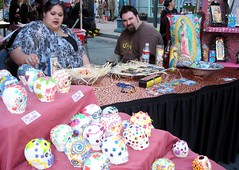
Conchita Iglesias McElwee and husband at Dia de los Muertos, Shreveport
Originally uploaded by trudeau
Local demographics discouraging: Louisiana continues to lose solid citizens to other states
Local demographer Elliott Stonecipher has tried to sound the alarm bell that contrary to what our leaders and others may be saying — Louisiana is losing residents to other states that offer more opportunity, writes Alison Bath in the Shreveport Times.
Population loss is a discouraging reaity but it's important to discuss. See the article here.
Population loss is a discouraging reaity but it's important to discuss. See the article here.
Friday, October 17, 2008
Quiz on recent 9 weeks material called Norte Americanos
Norte Americanos / Trudeau
1. Which nation is more distorted on a Mercator projection map? a) Brazil b) Argentina.
2. Greenwich, England, is home to the a) equator b) prime meridian c) oldest section of London d) the Earl of Sandwich.
3. One of these men was a cartographer: a) Vespucci
b) diCaprio c) Columbus d) McNally.
4. Parallels are lines of a) latitude or b) longitude.
5. A mountain range splits this city: a) NYC b) Los Angeles c) Chicago.
6. Barrack Obama’s political home: a) NYC b) Los Angeles c) Chicago.
7. Prime meridian: a) latitude b) longitude.
8. Latitude and longitude of Shreveport: a) 32N, 94E
b) 32E, 94N c) 32S, 94N d) 32N, 94W.
9. Prat Industries is the company behind Shreveport’s new recycling program. Their main business is recycling
a) paper b) wood c) plastics d) glass products.
Match a famous city with each of these coordinates:
10. 34N, 118W a) Boston b) Manila, Philippines c) Madrid, Spain d) Los Angeles
11. 19N, 99W a) Rio de Janeiro, Brazil b) Mecca, Saudi Arabia c) Mexico City
12. 22N, 115E a) Beijing, China b) Hong Kong, China c) Sydney, Australia
13. Louisiana finds itself most definitely in the __ climate type. a) Mediterranean b) Tropical wet & dry
c) Humid continental d) Humid subtropical.
14. The deposit of sediment by the Mississippi River, which keeps the land healthy via distribution of alluvial soil, was altered by the construction of __. a) canals b) bridges c) levees d) dams.
15. The French who were born in Louisiana colony were called a) Creoles b) Acadians c) Cajuns d) Gumbo.
16. Between their impoverished life in Western France and their impoverished life as pioneers in Louisiana, the French colonists spent about 150 years in a) the Caribbean b) British Columbia c) Toronto d) Acadia.
17. Guy Laliberté and Daniel Gather founded a) Canadian Waste Disposals Systems b) Cirque de Soleil c) the rock band Rush d) Quebec City.
18. The nation’s capital: a) Quebec b) Montreal c) Ottawa
d) Toronto.
19. Name for a bay in which the fresh water meets the salt water and wildlife and fish life is incubated: a) estuary b) delta c) sound d) strait .
20. Buenos Aires, Argentina a) 35N, 59E b) 35S, 59E c) 35S, 59W
1. Which nation is more distorted on a Mercator projection map? a) Brazil b) Argentina.
2. Greenwich, England, is home to the a) equator b) prime meridian c) oldest section of London d) the Earl of Sandwich.
3. One of these men was a cartographer: a) Vespucci
b) diCaprio c) Columbus d) McNally.
4. Parallels are lines of a) latitude or b) longitude.
5. A mountain range splits this city: a) NYC b) Los Angeles c) Chicago.
6. Barrack Obama’s political home: a) NYC b) Los Angeles c) Chicago.
7. Prime meridian: a) latitude b) longitude.
8. Latitude and longitude of Shreveport: a) 32N, 94E
b) 32E, 94N c) 32S, 94N d) 32N, 94W.
9. Prat Industries is the company behind Shreveport’s new recycling program. Their main business is recycling
a) paper b) wood c) plastics d) glass products.
Match a famous city with each of these coordinates:
10. 34N, 118W a) Boston b) Manila, Philippines c) Madrid, Spain d) Los Angeles
11. 19N, 99W a) Rio de Janeiro, Brazil b) Mecca, Saudi Arabia c) Mexico City
12. 22N, 115E a) Beijing, China b) Hong Kong, China c) Sydney, Australia
13. Louisiana finds itself most definitely in the __ climate type. a) Mediterranean b) Tropical wet & dry
c) Humid continental d) Humid subtropical.
14. The deposit of sediment by the Mississippi River, which keeps the land healthy via distribution of alluvial soil, was altered by the construction of __. a) canals b) bridges c) levees d) dams.
15. The French who were born in Louisiana colony were called a) Creoles b) Acadians c) Cajuns d) Gumbo.
16. Between their impoverished life in Western France and their impoverished life as pioneers in Louisiana, the French colonists spent about 150 years in a) the Caribbean b) British Columbia c) Toronto d) Acadia.
17. Guy Laliberté and Daniel Gather founded a) Canadian Waste Disposals Systems b) Cirque de Soleil c) the rock band Rush d) Quebec City.
18. The nation’s capital: a) Quebec b) Montreal c) Ottawa
d) Toronto.
19. Name for a bay in which the fresh water meets the salt water and wildlife and fish life is incubated: a) estuary b) delta c) sound d) strait .
20. Buenos Aires, Argentina a) 35N, 59E b) 35S, 59E c) 35S, 59W
Thw whole enchilada: North and South America Map
Notes on Fri, Oct 17:
The California Current and the Peru Current ply the western side of this hemisphere.
Both cold, cold currents, they have an intermittent and deleterious effect that we don't entirely understand. About every 3 years they are part of what we call El Nino ("the boy" or "the Christ child").
El Nino is associated with far flung storms, droughts & floods.
What';s the lesson of last month that is related to the basics of the El Nino phenomenon?
Ocean currents bringing storms from the African Atlantic coast to the Caribbean and the Gulf.
The California Current and the Peru Current ply the western side of this hemisphere.
Both cold, cold currents, they have an intermittent and deleterious effect that we don't entirely understand. About every 3 years they are part of what we call El Nino ("the boy" or "the Christ child").
El Nino is associated with far flung storms, droughts & floods.
What';s the lesson of last month that is related to the basics of the El Nino phenomenon?
Ocean currents bringing storms from the African Atlantic coast to the Caribbean and the Gulf.
Thursday, October 16, 2008
Made in Mexico: the less-expensive Fender Stratocasters
Fender has many of their amps and guitars made in Mexico today, according to Guitar Player magazine. Most players seem to feel that the Strats that are made in Mexico match the playability of competing guitars.
Many of today's bargain guitars are made in Korea.
Many of today's bargain guitars are made in Korea.
Made in Mexico: Ford Fusion
One of many companies trying to make cars economically, Ford is making the Fusion in Hermosillo, Mexico. That's according to BusinessWeek magazine, who says that Ford is having the Ford Fusion, Mercury Milan, and Lincoln Zephyr made there.
Many other corporations - Chrysler, Chevrolet, European companies, too - are doing the same thing.
Many other corporations - Chrysler, Chevrolet, European companies, too - are doing the same thing.
Made in Brazil: Embraer "regional jet," Continental Express
Embraer --, the Empresa Brasileira de Aeronáutica S.A., is a Brazilian aerospace conglomerate, says Wikipedia.
The company produces commercial, military, and corporate aircraft, as well as providing related aerospace services.
From 1999 to 2001 it was Brazil's largest exporter and is one of the three main exporters in Brazil. Among all aircraft manufacturers, it currently has the third[3] largest yearly delivery of commercial aircraft (behind Boeing, Airbus) and the third largest workforce (behind Boeing and Airbus).
If you fly out of a smaller airport like Shreveport Regional (SHV) you will probably be flying on an Embraer.
The company produces commercial, military, and corporate aircraft, as well as providing related aerospace services.
From 1999 to 2001 it was Brazil's largest exporter and is one of the three main exporters in Brazil. Among all aircraft manufacturers, it currently has the third[3] largest yearly delivery of commercial aircraft (behind Boeing, Airbus) and the third largest workforce (behind Boeing and Airbus).
If you fly out of a smaller airport like Shreveport Regional (SHV) you will probably be flying on an Embraer.
Wednesday, October 15, 2008
Three Crowded Cities quiz
Three Crowded Cities Quiz / Trudeau
Please answer
A for NYC
B for LA
C for Chicago.
1. Literature and art in a 1920’s movement called the Harlem Renaissance.
2. Tectonic plates and earthquakes.
3. The greatest variety of Buddhists in the US.
4. The Oprah Winfrey Show.
5. Cloud Gate, a sculpture called "The Bean."
6. Walt Disney Concert Hall.
7. The most densely populated US city.
8. Battery Park.
9. LaGuardia Airport.
10. Largest city in the most populous state.
11. City spread over a 500 square mile area.
12. El Pueblo de Nuestra Señora la Reina . . .
13. A mountain range splits this city.
14. Barack Obama’s political home.
15. Sears Tower, one of the world’s tallest buildings.
16. The second largest African American population in US.
17. The “Windy City“ is a nickname.
18. Mediterranean climate type.
19. ABC, NBC, CBS, Fox.
20. Erie Canal, 1825.
21. Mohicans.
Please write the number of correct answers at the top of the page!
1. a
2. b
3. b
4. c
5. c
6. b
7. a
8. a
9. a
10. b
11. b
12. b
13. b
14. c
15. c
16. c
17. c
18. b
19. a
20. a
21. a
Please answer
A for NYC
B for LA
C for Chicago.
1. Literature and art in a 1920’s movement called the Harlem Renaissance.
2. Tectonic plates and earthquakes.
3. The greatest variety of Buddhists in the US.
4. The Oprah Winfrey Show.
5. Cloud Gate, a sculpture called "The Bean."
6. Walt Disney Concert Hall.
7. The most densely populated US city.
8. Battery Park.
9. LaGuardia Airport.
10. Largest city in the most populous state.
11. City spread over a 500 square mile area.
12. El Pueblo de Nuestra Señora la Reina . . .
13. A mountain range splits this city.
14. Barack Obama’s political home.
15. Sears Tower, one of the world’s tallest buildings.
16. The second largest African American population in US.
17. The “Windy City“ is a nickname.
18. Mediterranean climate type.
19. ABC, NBC, CBS, Fox.
20. Erie Canal, 1825.
21. Mohicans.
Please write the number of correct answers at the top of the page!
1. a
2. b
3. b
4. c
5. c
6. b
7. a
8. a
9. a
10. b
11. b
12. b
13. b
14. c
15. c
16. c
17. c
18. b
19. a
20. a
21. a
Guidelines for an effective Thank you note
a) Generalities such as "Awesome," are nice but vague.
b) Being specific, such as "Thank you for the $30 check," brings a satisfying element to your note.
c) "Your enchiladas were tender and sweet" is better than "Your food was outstanding."
d) "I learned about Indian garments known as saris and salwar kameez from you," brings important detail to a speaker's thank you note.
e) Being specific and detailed is good writing in general; it's effective communication.
b) Being specific, such as "Thank you for the $30 check," brings a satisfying element to your note.
c) "Your enchiladas were tender and sweet" is better than "Your food was outstanding."
d) "I learned about Indian garments known as saris and salwar kameez from you," brings important detail to a speaker's thank you note.
e) Being specific and detailed is good writing in general; it's effective communication.
Indie work: comaprison essay on mariachis and samba
The folk musics of Mexico and Brazil are delicious: mariachi and samba. Read about them and write your integrated essay.
Geography students will celebrate the Mexican fiesta called Dia de los Muertos
Food and activities are being planned by groups in each class for a Mexican celebration called Dia de los Muertos, Day of the Dead.
Though it is held on Nov 1 and 2 in Mexico, we will have ours on Fri, Oct 31.
Hopefully we will have the making of an ofrendas, an altar of offerings, to an important deceased person.
Papel picado amd pan de los Muertos may be included.
Though it is held on Nov 1 and 2 in Mexico, we will have ours on Fri, Oct 31.
Hopefully we will have the making of an ofrendas, an altar of offerings, to an important deceased person.
Papel picado amd pan de los Muertos may be included.
A bit of South America in Shreveport: Macondo, corner Youree and Ockley
Janine Demerath is the proprietor of the clothing and jewelry shop callled Macondo. She is a Peruvian American who teaches Spanish for LSU and Centenary College. Her husband is Centenary prof Loren Demerath; he can often be seen walking their 2 children to school at Montessori of Shreveport.
Her shop has been stocked with heart and soul. She truly sees it as symbolic of the folk side of South America.
You may write an essay of description on Macondo for indie work. It is part of the Mattress Shop across Youree from AC Steere.
Her shop has been stocked with heart and soul. She truly sees it as symbolic of the folk side of South America.
You may write an essay of description on Macondo for indie work. It is part of the Mattress Shop across Youree from AC Steere.
Tuesday, October 14, 2008
Deborah Morehead's lecture on village life in India
The illustrated story told by Mrs. Morehead is based on a journey to Raipur, India, for mission activity in rural villages.
- Mrs. M wore a salwar kameez (spelling varies on these Hindi clothing terms), the traditional Indian tunic top and flowing pants.
- She showed us a sari, a giant rectangular fabric piece that forms the basic dress of Indian women.
- also: the filmy, long scarf - 6 to 8 ft - known as the dopatta, traditionally worn by both the Muslim and Sikh women in India.
- she had me model the longhi, a rectangle of cotton fabric worn as a skirt by working class men. When folded under the legs, it is called a dhoti.
One of the aims of the Morehead visit was to bring snakebite kits to rural people who have little protection from the bites of poisonous snakes.
A theme of her talk was the difficulty of getting water in India. Women walk to a well each day to get water for the house; they bring it home in pots perched on their heads. And nearly all their water is to some degree polluted. Many children in India die from water-borne diseases.
Indian students raised in the US have typically not observed Indian village life, says Morehead.
- Mrs. M wore a salwar kameez (spelling varies on these Hindi clothing terms), the traditional Indian tunic top and flowing pants.
- She showed us a sari, a giant rectangular fabric piece that forms the basic dress of Indian women.
- also: the filmy, long scarf - 6 to 8 ft - known as the dopatta, traditionally worn by both the Muslim and Sikh women in India.
- she had me model the longhi, a rectangle of cotton fabric worn as a skirt by working class men. When folded under the legs, it is called a dhoti.
One of the aims of the Morehead visit was to bring snakebite kits to rural people who have little protection from the bites of poisonous snakes.
A theme of her talk was the difficulty of getting water in India. Women walk to a well each day to get water for the house; they bring it home in pots perched on their heads. And nearly all their water is to some degree polluted. Many children in India die from water-borne diseases.
Indian students raised in the US have typically not observed Indian village life, says Morehead.
Monday, October 13, 2008
Roda do Capoeira: amazing art of Brazil
Capoeira (IPA: [ka.pu.ˈej.ɾɐ]) is a brazilian art form that ritualizes movement from martial arts, games, and dance, says Wikipedia.
It was created in Brazil some time after the 16th century in the regions known as Bahia, Pernambuco, Rio de Janeiro, Minas Gerais, and São Paulo.
Participants form a roda or circle and take turns either playing musical instruments (such as the Berimbau), singing, or ritually sparring in pairs in the center of the circle. The game is marked by fluid acrobatic play, feints, and extensive use of groundwork, including sweeps, kicks, and headbutts. Less frequently used techniques include elbow-strikes, slaps, punches, and body throws.
Its origins and purpose are a matter of heated debate, with the spectrum of argument ranging from views of Capoeira as a uniquely Brazilian folk dance to claims that it is a battle-ready fighting form directly descended from ancient African technique.
It was created in Brazil some time after the 16th century in the regions known as Bahia, Pernambuco, Rio de Janeiro, Minas Gerais, and São Paulo.
Participants form a roda or circle and take turns either playing musical instruments (such as the Berimbau), singing, or ritually sparring in pairs in the center of the circle. The game is marked by fluid acrobatic play, feints, and extensive use of groundwork, including sweeps, kicks, and headbutts. Less frequently used techniques include elbow-strikes, slaps, punches, and body throws.
Its origins and purpose are a matter of heated debate, with the spectrum of argument ranging from views of Capoeira as a uniquely Brazilian folk dance to claims that it is a battle-ready fighting form directly descended from ancient African technique.
Panthalassa, Pangea, the Tethys Sea and the Paleozoic Era
Pangaea, or Pangea, - from παν, pan, meaning entire, and Γαῖα, Gaea, meaning Earth in Ancient Greek - was the supercontinent that existed during the Paleozoic and Mesozoic eras about 250 million years ago, before the component continents were separated into their current configuration [2].
The name was first used, says Wikipedia, by the German originator of the continental drift theory, Alfred Wegener, in the 1920 edition of his book The Origin of Continents and Oceans (Die Entstehung der Kontinente und Ozeane), in which a postulated supercontinent Pangaea played a key role.
Paleogeographic reconstructions show Pangaea as a roughly C-shaped landmass that was spread across the equator. The body of water that was enclosed within the resulting crescent has been named the Tethys Sea. Owing to Pangaea's massive size, the inland regions appear to have been very dry. The large supercontinent would potentially have allowed terrestrial animals to migrate freely.
The vast ocean that surrounded the supercontinent of Pangaea has been named Panthalassa, which means "all seas". The break-up of Pangaea began about 180 million years ago in the Jurassic Period. First it separated into two supercontinents (Gondwana to the south and Laurasia to the north), thereafter into the continents we have today.
The name was first used, says Wikipedia, by the German originator of the continental drift theory, Alfred Wegener, in the 1920 edition of his book The Origin of Continents and Oceans (Die Entstehung der Kontinente und Ozeane), in which a postulated supercontinent Pangaea played a key role.
Paleogeographic reconstructions show Pangaea as a roughly C-shaped landmass that was spread across the equator. The body of water that was enclosed within the resulting crescent has been named the Tethys Sea. Owing to Pangaea's massive size, the inland regions appear to have been very dry. The large supercontinent would potentially have allowed terrestrial animals to migrate freely.
The vast ocean that surrounded the supercontinent of Pangaea has been named Panthalassa, which means "all seas". The break-up of Pangaea began about 180 million years ago in the Jurassic Period. First it separated into two supercontinents (Gondwana to the south and Laurasia to the north), thereafter into the continents we have today.
Sunday, October 12, 2008
Oct 13 - 17: presentations on Brazil and Mexico and a 20 item quiz on Thurs
1. Presentations begin Mon or Tues on the work we did last week in the computer lab and library. Brief, clean powerpoint-type projections on Mexico & Brazil.
15 pts.
2. Thurs: open notes quiz based on questions that have been previously presented on other quizzes. 20 multi-choice items.
3. Links to your digital portfolios: please email me the link so I can give you credit.
4. Indie work: the last day this week would be Friday.
15 pts.
2. Thurs: open notes quiz based on questions that have been previously presented on other quizzes. 20 multi-choice items.
3. Links to your digital portfolios: please email me the link so I can give you credit.
4. Indie work: the last day this week would be Friday.
From Pangaea to Oceania: the basic calendar of units, '08 - 09
As guided by the comprehensive curriculum, which insures topical uniformity across the parish . . .
Aug: basic skills in geography (2 weeks)
Sept: US & Canada (4)
Oct: Central & South America & the Caribbean (3) also, Europe begins.
Oct 17: end of 9 weeks.
Nov 4: schools closed for presidential election.
Nov: Europe (4)
Nov 24: Fall break week.
Dec: Russia & Northern Eurasia (3)
Dec 22: Winter break.
Jan 5: class resumes.
Jan 7 - 9: Semester exams.
Jan 12: Middle East (SW Asia) & Mediterranean Africa
Jan 16: students at home / teacher professional dev. day.
Jan 19: MLK, Jr.
Feb: Sub-Saharan Africa (3)
Feb 16: Presidents' Day
March: South & Central Asia (3)
March 20: end of 9 weeks.
April 1 - 7: state testing.
April: East Asia (3)
April 13 - 19: Spring break.
May: Australia & Oceania
May 12 - 14: senior finals
May 25: Memorial day.
May 27 - 29: semester exams.
May 27: last day for students.
Aug: basic skills in geography (2 weeks)
Sept: US & Canada (4)
Oct: Central & South America & the Caribbean (3) also, Europe begins.
Oct 17: end of 9 weeks.
Nov 4: schools closed for presidential election.
Nov: Europe (4)
Nov 24: Fall break week.
Dec: Russia & Northern Eurasia (3)
Dec 22: Winter break.
Jan 5: class resumes.
Jan 7 - 9: Semester exams.
Jan 12: Middle East (SW Asia) & Mediterranean Africa
Jan 16: students at home / teacher professional dev. day.
Jan 19: MLK, Jr.
Feb: Sub-Saharan Africa (3)
Feb 16: Presidents' Day
March: South & Central Asia (3)
March 20: end of 9 weeks.
April 1 - 7: state testing.
April: East Asia (3)
April 13 - 19: Spring break.
May: Australia & Oceania
May 12 - 14: senior finals
May 25: Memorial day.
May 27 - 29: semester exams.
May 27: last day for students.
1. Gather donations 2. Buy crepe myrtles 3. Plant them 4. Enjoy their growth
The Class of 2012 has the opportunity to add a great deal of beauty to the campus by planting crepe myrtles on the north side of the campus. It gets you out of class, too.
The thing to do is
a) Donate as much $ as you can. Parents can send checks payable to Cmhs.
b) A parent will help by purchasing the trees.
c) Bring shovels to school for bonus points.
d) Have a planting day.
e) Pray for rain.
f) Enjoy the growth - the beauty will affect the city as well as the Cmhs community.
Your class officers, Tim, Lexi, Cici and Heather, will lead the fund-raising and planning.
The thing to do is
a) Donate as much $ as you can. Parents can send checks payable to Cmhs.
b) A parent will help by purchasing the trees.
c) Bring shovels to school for bonus points.
d) Have a planting day.
e) Pray for rain.
f) Enjoy the growth - the beauty will affect the city as well as the Cmhs community.
Your class officers, Tim, Lexi, Cici and Heather, will lead the fund-raising and planning.
Vanilla & chocolate both originate in Mexico
Vanilla is a flavoring derived from orchids of the genus Vanilla native to Mexico. Etymologically, vanilla derives from the Spanish word "vainilla", little pod, says Wikipedia. [1]
Originally cultivated by Pre-Colombian Mesoamerican peoples, Spanish conquistador Hernán Cortés is credited with introducing both the spice and chocolate to Europe in the 1520s.
Chocolate comprises a number of raw and processed foods that are produced from the seed of the tropical cacao tree. Cacao has been cultivated for at least three millennia in Central America and Mexico, with its earliest documented use around 1100 BC.
The majority of the Mesoamerican peoples made chocolate beverages, including the Maya and Aztecs, who made it into a beverage known as xocolātl, a Nahuatl word meaning "bitter water".
The Europeans would, much later, add sugar and create Milk Chocolate, the magical edible that you and I crave.
Originally cultivated by Pre-Colombian Mesoamerican peoples, Spanish conquistador Hernán Cortés is credited with introducing both the spice and chocolate to Europe in the 1520s.
Chocolate comprises a number of raw and processed foods that are produced from the seed of the tropical cacao tree. Cacao has been cultivated for at least three millennia in Central America and Mexico, with its earliest documented use around 1100 BC.
The majority of the Mesoamerican peoples made chocolate beverages, including the Maya and Aztecs, who made it into a beverage known as xocolātl, a Nahuatl word meaning "bitter water".
The Europeans would, much later, add sugar and create Milk Chocolate, the magical edible that you and I crave.
Saturday, October 11, 2008
First year students to hear author-climber Weihenmayer on Mon, Oct 13
Ninth grade students will go by school bus to a lecture by Erik Weihenmayer on Monday. The trip will take place between 9 and 12, says the info sheet.
ERIK WEIHENMAYER
World-Class Adventurer
On May 25, 2001, Erik Weihenmayer became the only blind man in history to reach the summit of the world's highest peak - Mount Everest. And on September 5, 2002, when he stood on top of Mt. Kosciusko in Australia, Weihenmayer completed his 7-year quest to climb the Seven Summits - the highest mountains on each of the seven continents, joining only 100 mountaineers who have accomplished that feat. At age 33, he was also one of the youngest. Additionally, he has scaled El Capitan, a 3300-foot overhanging rock wall in Yosemite; Polar Circus, a 3000-foot ice waterfall in The Canadian Rockies; and a difficult and rarely climbed rock face on 17,000-foot Mt. Kenya.
In September, 2003, Erik joined 320 stellar athletes from 17 countries to compete in the Primal Quest, the richest and toughest multi-sport adventure race in the world: 457 miles through the Sierra Nevada's, nine days, sixty thousand feet of elevation gain, and no time-outs. Averaging only two hours of sleep a night, Erik and his team surged past the finish line on Lake Tahoe, becoming one of the 42 teams to cross the finish line out of the 80 teams that began.
After Erik's Mt. Everest ascent, Braille Without Borders, a school for the blind in Tibet, invited him to teach its students mountaineering and rock climbing. His many climbs gave the teenagers the courage to excel in a culture which affords few opportunities for the blind. Erik and six Everest team members went to Tibet in May 2004 to train the students, then in October led them on a climb to the Rombuk Glacier on the north side of Mt. Everest. Once seen as pariahs, the teenagers ultimately stood together at 21,500-feet., higher than any team of blind people in history.
Steven Haft, producer of such blockbusters as Dead Poets' Society, made a documentary on the ascent which opened to standing ovations at the Toronto, L.A., and London Film Festivals. The film will be released theatrically in spring of 2007.
More at Touchthetop.com.
ERIK WEIHENMAYER
World-Class Adventurer
On May 25, 2001, Erik Weihenmayer became the only blind man in history to reach the summit of the world's highest peak - Mount Everest. And on September 5, 2002, when he stood on top of Mt. Kosciusko in Australia, Weihenmayer completed his 7-year quest to climb the Seven Summits - the highest mountains on each of the seven continents, joining only 100 mountaineers who have accomplished that feat. At age 33, he was also one of the youngest. Additionally, he has scaled El Capitan, a 3300-foot overhanging rock wall in Yosemite; Polar Circus, a 3000-foot ice waterfall in The Canadian Rockies; and a difficult and rarely climbed rock face on 17,000-foot Mt. Kenya.
In September, 2003, Erik joined 320 stellar athletes from 17 countries to compete in the Primal Quest, the richest and toughest multi-sport adventure race in the world: 457 miles through the Sierra Nevada's, nine days, sixty thousand feet of elevation gain, and no time-outs. Averaging only two hours of sleep a night, Erik and his team surged past the finish line on Lake Tahoe, becoming one of the 42 teams to cross the finish line out of the 80 teams that began.
After Erik's Mt. Everest ascent, Braille Without Borders, a school for the blind in Tibet, invited him to teach its students mountaineering and rock climbing. His many climbs gave the teenagers the courage to excel in a culture which affords few opportunities for the blind. Erik and six Everest team members went to Tibet in May 2004 to train the students, then in October led them on a climb to the Rombuk Glacier on the north side of Mt. Everest. Once seen as pariahs, the teenagers ultimately stood together at 21,500-feet., higher than any team of blind people in history.
Steven Haft, producer of such blockbusters as Dead Poets' Society, made a documentary on the ascent which opened to standing ovations at the Toronto, L.A., and London Film Festivals. The film will be released theatrically in spring of 2007.
More at Touchthetop.com.
Somehow, expecting all A's and B's: your Cmhs parents
Indie work this week -
Read and research before you write a comparison essay - follow the guidelines - and try one of these topics:
- Mexico and Brazil
- Today's Wall St financial crisis and the 1929 stock market crash and Great Depression
- Gulf of Mexico and the Caribbean
Read and research before you write a comparison essay - follow the guidelines - and try one of these topics:
- Mexico and Brazil
- Today's Wall St financial crisis and the 1929 stock market crash and Great Depression
- Gulf of Mexico and the Caribbean
Friday, October 10, 2008
Coral reefs in danger worldwide
Coral reef is a type of underwater environment shaped by limestone formations. Reef limestone consists largely of a framework of skeletons from marine animals called corals, says worldbookonline.
Reefs also contain the remains of other limestone-producing organisms, such as algae and shellfish, as well as sand and other particles. A coral reef is a complex, biologically rich ecosystem—that is, a community of living things and their environment. Many of the world's most colorful animals live in coral reefs. Reefs also provide important benefits to people and to the larger environment.
Coral animals produce formations that may resemble branching trees, large domes, small irregular crusts, or tiny organ pipes. They can glow with rich colors, including beautiful shades of green, orange, purple, tan, and yellow.
Coral reefs lie mainly in shallow tropical or subtropical seas. Most reef-forming corals cannot live in water colder than 61 to 68 °F (16 to 20 °C). Reefs require enough sunlight to support photosynthesis in their algae and plants. Photosynthesis is the process in which organisms use energy from sunlight to make food.
Reefs aid people in numerous ways. Many societies depend on reef animals for food. Coral reefs also benefit the economies of some nations by drawing large numbers of tourists. In medicine, doctors use coral limestone to replace parts of human bones, and medical researchers believe chemicals from certain reef organisms may help them discover new medicines.
Despite the benefits coral reefs provide, human activities have led to the destruction of many reef environments. The fishing industry poses numerous threats to reefs. Fishing methods using dynamite, cyanide, or bleach can destroy coral life. Overfishing may upset reef stability by endangering certain reef species. Ships passing too close to reefs can hit and damage them.
The widespread burning of fossil fuels also damages reefs. Such pollution produces large amounts of carbon dioxide in the atmosphere. Excess carbon dioxide contributes to global warming, and thus to a rise in ocean temperatures. High water temperatures can cause corals to bleach and die. Bleaching occurs when corals become stressed and their zooxanthellae die or are expelled from the polyps.
Many other human activities harm coral reefs. Deforestation (cutting down forests) causes soil to wash into the sea and block out sunlight that corals need to survive. Agricultural fertilizers seep into oceans and promote the overgrowth of algae that smother polyps. The development of seaside homes and hotels may cause pollution that poisons corals.
Reefs also contain the remains of other limestone-producing organisms, such as algae and shellfish, as well as sand and other particles. A coral reef is a complex, biologically rich ecosystem—that is, a community of living things and their environment. Many of the world's most colorful animals live in coral reefs. Reefs also provide important benefits to people and to the larger environment.
Coral animals produce formations that may resemble branching trees, large domes, small irregular crusts, or tiny organ pipes. They can glow with rich colors, including beautiful shades of green, orange, purple, tan, and yellow.
Coral reefs lie mainly in shallow tropical or subtropical seas. Most reef-forming corals cannot live in water colder than 61 to 68 °F (16 to 20 °C). Reefs require enough sunlight to support photosynthesis in their algae and plants. Photosynthesis is the process in which organisms use energy from sunlight to make food.
Reefs aid people in numerous ways. Many societies depend on reef animals for food. Coral reefs also benefit the economies of some nations by drawing large numbers of tourists. In medicine, doctors use coral limestone to replace parts of human bones, and medical researchers believe chemicals from certain reef organisms may help them discover new medicines.
Despite the benefits coral reefs provide, human activities have led to the destruction of many reef environments. The fishing industry poses numerous threats to reefs. Fishing methods using dynamite, cyanide, or bleach can destroy coral life. Overfishing may upset reef stability by endangering certain reef species. Ships passing too close to reefs can hit and damage them.
The widespread burning of fossil fuels also damages reefs. Such pollution produces large amounts of carbon dioxide in the atmosphere. Excess carbon dioxide contributes to global warming, and thus to a rise in ocean temperatures. High water temperatures can cause corals to bleach and die. Bleaching occurs when corals become stressed and their zooxanthellae die or are expelled from the polyps.
Many other human activities harm coral reefs. Deforestation (cutting down forests) causes soil to wash into the sea and block out sunlight that corals need to survive. Agricultural fertilizers seep into oceans and promote the overgrowth of algae that smother polyps. The development of seaside homes and hotels may cause pollution that poisons corals.
Fri: Map of Mexico and a Caribbean thread . . .
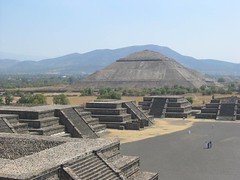
Pirámide del Sol y templos en la Avenida de la Muerte- Pyramid of the Sun and temples along the Avenue of the Dead, Teotihuacán near Mexico City
Originally uploaded by hanneorla
On the map:
Population: about one-third the US population.
2 great cities:
- Mexico, DF (Distrito Federale, like Wash, DC)
- Guadalajara
2 states:
- Chihuahua, in the north
- tabasco, in the Gulf south
2 Yucatan resorts?
- Cancun
- Cozumel
2 bodies of water around the Yucatan?
- Gulf of Mexico
- Caribbean
Why is Caribbean water typically clear and, thus, so appealing?
- coral filters the water.
Making a design for Magnet? here's the new logo . . .
Use this logo when you're working on Magnet-related designs and you'll flow with the school's current graphic plan.
Click on the logo to access various sizes, including a thumbnail.
Click on the logo to access various sizes, including a thumbnail.
Wednesday, October 08, 2008
Jessica says, "Here are the answers to the Vancouver to Montreal quiz. Hope you did well."
Also known as the Victoria to Quebec quiz . . .
1. True
2. A Nova Scotia
3. B Eng & Fr
4. B Iberville
5. A Creoles
6. D Acadia
7. B Cirque de Soleil
8. C Ottawa (I misspelled it on the quiz - apologies)
9. B or D Both the Erie Canal and the St Lawrence
10. T archipelago
11. B Western - where the principal mountains erupt.
12. D Montreal
1. True
2. A Nova Scotia
3. B Eng & Fr
4. B Iberville
5. A Creoles
6. D Acadia
7. B Cirque de Soleil
8. C Ottawa (I misspelled it on the quiz - apologies)
9. B or D Both the Erie Canal and the St Lawrence
10. T archipelago
11. B Western - where the principal mountains erupt.
12. D Montreal
Tuesday, October 07, 2008
Brazil and Mexico: a geography class presentation project
Comparing Mexico and Brazil
Create a 10-slide powerpoint presentation based on
the possibilities in this list. You may focus entirely on Mexico, or on Brazil. Or, if you are an advanced student, you may create a comparison project.
- Each slide must be based on a high-resolution image.
- Info on slides must be Very brief, bulleted material.
- There will be no narration, therefore each slide must be self-explanatory.
- Sources must be cited in slide 10.
- Titling must be offered on slide 1.
- No transitions or animated type, please.
- Each project must include 2 examples of the nation’s relationship with the US.
1. Type of government
2. demographics: national population, top 3 urban pops.
3. national language (s)
4. colonial nations who were in control
5. GDP (gross domestic product) per capita (per person), a measurement of the nation’s wealth
6. indigenous peoples (2)
7. resources exploited by colonial powers
8. major topographical features (2)
9. major exports (3)
10. natural resources (3)
11. types of national music (2)
12. festival(s)
13. sports (2)
14. leaders of European discoveries
15. 2 examples of its relationship with the US
16. map with 3 most populous cities on their sites
17. list of neighboring nations
18. Eco-regions (2)
19. biodiversity (3)
20. wildlife (5)
21. indigenous foods
22. tourism
Create a 10-slide powerpoint presentation based on
the possibilities in this list. You may focus entirely on Mexico, or on Brazil. Or, if you are an advanced student, you may create a comparison project.
- Each slide must be based on a high-resolution image.
- Info on slides must be Very brief, bulleted material.
- There will be no narration, therefore each slide must be self-explanatory.
- Sources must be cited in slide 10.
- Titling must be offered on slide 1.
- No transitions or animated type, please.
- Each project must include 2 examples of the nation’s relationship with the US.
1. Type of government
2. demographics: national population, top 3 urban pops.
3. national language (s)
4. colonial nations who were in control
5. GDP (gross domestic product) per capita (per person), a measurement of the nation’s wealth
6. indigenous peoples (2)
7. resources exploited by colonial powers
8. major topographical features (2)
9. major exports (3)
10. natural resources (3)
11. types of national music (2)
12. festival(s)
13. sports (2)
14. leaders of European discoveries
15. 2 examples of its relationship with the US
16. map with 3 most populous cities on their sites
17. list of neighboring nations
18. Eco-regions (2)
19. biodiversity (3)
20. wildlife (5)
21. indigenous foods
22. tourism
Subscribe to:
Posts (Atom)
